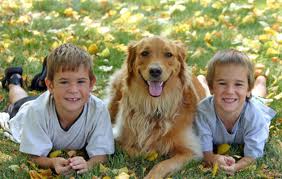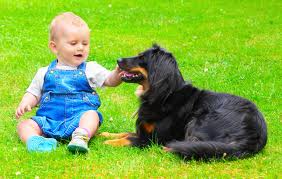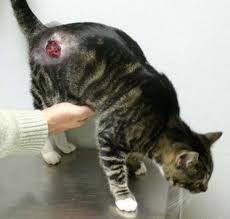 1. Pets help children develop, easier to adapt and find new friends
1. Pets help children develop, easier to adapt and find new friends
This dog, cat, rat or a parrot – this is the dream of all children. They appreciate the contact with animals. Your pet becomes a child is not only a source of warmth, affection and companion in games, and has a strong influence on the child. For example, the relationship between the child and the dog are of great pedagogical value. If a child wants to have a dog, which means that it is developing harmoniously. In society, the dog learns to be a child organized and be with others. Scientists have proved that animals can help children develop faster, easier to adapt to a new team and find friends, and shared care for animals, rides and games make family friendly.
2. Pets contribute to the physical development of children
Cats and dogs stimulate the child to the outdoor games, and develop coordination. Playing with the dog at the ball, the child involved in an interesting mobile game. In humans, contact with animals, decreased heart rate, blood pressure, heart rate slows, muscles relax, improves digestion. Life expectancy increases to 15 years. Studies show the value pets and recommend them as a medicine.
3. Pets – the best psychologists and assistants
Animals for the children – this is the best psychologists and assistant in matters of social adaptation. Sometimes an animal becomes a “link” between a shy child and his potential friends in the yard. The dog makes a contribution to the establishment of the child’s contact with the surrounding joint. A walking the dog can unite even the most taciturn and problem children. After all, what you heard the dog, increases self-esteem, which may further favorably affect the communication with the outside world. We all know that communication with the animal relieves stress and builds relationships within the family. Communication with the pet can push a child to explore the world and nature.
And a dog can teach a child to read: Here is an example: an 8-year-old boy, who could read only 45 words per minute, per month doubled the speed of reading through rate. Dog Left Behind student visited the school every week and patiently, curled up, lying on the lap of the boy while he was reading aloud. No one corrected the child is not interrupted and did not comment. In such a nice company hated reading before turning into a real pleasure. The calming effect of contact with domestic animals has long been known. Teachers say that children with a friendly four-legged listener changing right before our eyes: disappear fear, anxiety and uncertainty. Hence the excellent results.
4. Pets bring up a sense of responsibility
Pet teaches children responsibility for themselves and those close to him creatures. Doctors, psychologists and educators recommend a child a pet as a friend, who gives him not only to their proximity, but also the recognition and communication, and understanding of responsibility for themselves and those close to him creatures. The child will understand that the four-legged friend is not a teddy bear, it must be fed regularly, look and walk. These skills will help a child into adulthood, he learns to control himself and take responsibility for their actions. At different ages the degree of responsibility for the child in the animal should be varied. In 3 years the child can help fill food, pet him, together with you to walk it. In 7-9 years a child can begin to walk the dog yourself, and C13-ty years to become the master and bear responsibility for a pet.
5. The communicative aspect of. Pet – a super-topic to discuss with friends. Your child is interested in cats, dogs or other animals? Let him read the special literature, go with him on the show and keep his endeavors and aspirations. After contact with animals can become his hobby, which will create around the child the appropriate circle of friends and acquaintances.
Tag Archive | pets veterinary
Animals in the House
 People of different professions and ages much of his free time paid breeding pets. One is a hobby brings joy of communion with nature, others see his team of friends who love to pay to them a touching affection. In most families there are animals in the house at the request of children for whom particularly high cognitive and educational importance of communication with animals. Caring for fish, birds and small animals instills industriousness, punctuality, creative skills, and respect for all living things.
People of different professions and ages much of his free time paid breeding pets. One is a hobby brings joy of communion with nature, others see his team of friends who love to pay to them a touching affection. In most families there are animals in the house at the request of children for whom particularly high cognitive and educational importance of communication with animals. Caring for fish, birds and small animals instills industriousness, punctuality, creative skills, and respect for all living things.
Setting the stage for the animals in the house, the family takes up a lot of concern that require some expenditure of funds, time and effort. Requires some skill, patience, discipline and knowledge of biological features of the animal. Of the more than half a million different species of animals in the home may well exist and be safe for humans, less than 1%. Sometimes people are trying to help those in need wild animals, take them home, so that in some time to release them back to freedom is stronger and healthier. But such altruism can result in disaster – tamed young animals, as adults, can no longer live independently and die. In this case it is better to leave the pet at home or transfer to the pet store, a school of living area, a station of young naturalists.
At present, opportunities for breeding in the home increased significantly: introduced new types of pets, in most major cities of the specialized pet shops are open, amateur associations are created, published a lot of literature.
Among domestic animals the most popular and widespread are exotic fish and other inhabitants of the aquarium. Aquarium – is not only container, a vessel for the content of aquatic organisms, and the specific biological system capable of self-regulation. Is rectangular, cylindrical, round, nodular with truncated apex, etc. Buy an aquarium, as well as his pets in pet stores can. To create a normal environment you need to create at the bottom of the tank bottom (sand, gravel, pebbles, shells), dilute aquatic plants and algae (water sprouts, , kobomba, Ricci uviranda and others), to acquire or produce their own devices for additional light and oxygen saturation of water. The aquarium can live as inhabitants of the local rivers and lakes (bitterling, eel, rudd, tench, gudgeon) as well as various types of exotic fish (Chinese, and calico telescope, the comet, celestial eye, a common goldfish and many others). Buying fish, you should consult the compatibility of different species and their feeding. It is best to refer to the literature.
More and more amateurs home terrarium – space for amphibians and reptiles content, as well as invertebrates and small mammals. However, keeping animals in terrariums little studied and is poorly lit in a special and methodological literature. First of all, must be carefully insulated enclosure to prevent the possibility of leaving his animals and the creation of a specific microclimate: a certain temperature, humidity, etc., Terrarium, usually manufactured without cracks of thick metal wire and a wall of glass (for observation). It can include toads, frogs, newts, snakes, turtles and lizards.
Fun activity is to breed the birds. When deciding to purchase feathered friends, you need to find out if someone is suffering from allergic diseases of family members, as the presence of birds in the house sometimes contributes to their aggravation. Do not rush to buy birds at random people, but before examining the requirements of feeding and caring for feathered refer to the pet store or a section of the amateur poultry. At home, the birds are kept in cages, aviaries or cages. Of the herbivorous birds can live in captivity sparrow grosbeak, finch, linnet, bunting, waxwing, bird, bullfinch, siskin, goldfinch, from insectivorous – lark, robin, common nightingale, singing thrush, nuthatch, starling, wagtail other. The most common is domestic content of exotic birds, especially parrots. They are all herbivorous, and many of them well to imitate human speech and are long-lived (live 50 – 80 years). Among poultry in the territory of Russia, the most common budgerigar, finch rack, parrot, gray parrot, pink cockatoos, and others.
When breeding wild or domestic mammals, in addition to the conditions and feeding, it is necessary to consider a number of ethical and sometimes legal issues. All mammals have well-developed psychic, teachable, trainable, responsive to affection and pain. In this regard, human relationships with them are governed by a number of legal acts: the rules of detention, transportation, quarantine, the decrees of the responsibility for cruelty to animals, etc. But there are unwritten laws of kindness and humanity. Therefore, to decide on the content of the mammals in the house should be, considering its capabilities and features of the animal.
From wild animals at home can live successfully protein, hedgehog, loir, hamster (Syrian or Central Asian).
Of the 300 breeds of dogs in the home would be best to include decorative. This variety of poodles, terriers, as well as Western and Oriental decorative dog (Maltese lap dog, or french, dwarf Pinscher, Pug, French Bulldog, Japanese Chin, Pekingese, and others).The plant in the house dog of any breed, it must be remembered that it is not a toy, but above all else and demands appropriate attention. Dog – the most loyal, selfless, forgiving, and understanding to each lot. Quite a few pleasant minutes delivers the contents of the house and different types of cats. They, like dogs, are the most common domestic mammals.
Any pets in the house – is not only worries and troubles, but above all it is an immeasurable joy of living creatures, with a part of nature.
Leukemia Virus in Cats.
 Feline Leukemia Virus (WFC, FeLV, or from the English. Feline leukemia virus) – this is a well-known killer. FeLV weakens the immune system and also has a direct impact on the development of cancer in infected cats. This disease is considered the most dangerous infection in cats, resulting in death.
Feline Leukemia Virus (WFC, FeLV, or from the English. Feline leukemia virus) – this is a well-known killer. FeLV weakens the immune system and also has a direct impact on the development of cancer in infected cats. This disease is considered the most dangerous infection in cats, resulting in death.
Although there is a vaccine against this deadly disease, they do not always give a positive result. As in the case of FIV, the best way to protect your cat from leukemia – to do the appropriate tests and to protect it from infected animals. Ideally, this means to keep her indoors only, one or the other, also non-infected cats.
Do tests to all new cats or kittens before bringing them into his house, where there are other cats. (Prior to vaccinate an animal, at first he in any case, do an analysis on the FeLV.) Your cats should also make the tests again after they have been in contact with potential carriers of FeLV, especially if your cat is bitten. Symptoms vary FeLV, so sick cat should be tested for FeLV. Cats walking on the street, or those who have been in contact with potential carriers of FeLV, testing should be done annually.
Most vets do a combined analysis for FIV and FeLV, which allows to determine the presence of both of these viral diseases with one blood sampling.
FeLV – this is very serious. Do not allow yourself to succumb to self-pity and take home a cat, she is not making pre-analysis on FeLV, especially if you are already living in the house of other cats. By doing so, you may be putting at risk the lives of their pet cats. But if it did happen and you find that allowed their contact with domestic cats FeLV-infected animals, do not panic. Isolate from infected their cats and take them to tests in accordance with the instructions of a veterinarian. After a contact transmission can not occur. Sometimes it takes a long time and repeated contact. So hope for the best and avoid further contact.
But what if analysis on your cat has FeLV was positive? The first thing you must understand that being a carrier of the virus does not mean to be sick. Some, in other respects healthy cats with a positive response to FeLV, live for months or even years without any symptoms of the disease. If an infected cat is the only thing your pet, the following guidelines. First, do not let her out, she was unable to infect other cats, as well as pick up any infections from them. Second, spend all the necessary preventive measures, the cat is not sick with something else, and collaborate with your veterinarian to diagnose and cure time associated with any FeLV disease that can develop in cats.
Most often the disease occurs in the form of lymphosarcoma, in particular the thymus. At the same time by progressive atrophy of the thymus and increases immunosuppression, neutropenia is detected. Sometimes the disease is in the form of myeloid leukemia. Sick cats are particularly susceptible to the virus to others, as well as to bacterial and fungal infections.
Symptoms. Cat exhausted, say fever, anorexia, lethargy, pallor of mucous membranes, glossitis, stomatitis, frequent breast cancer, glomerulonephritis, skin disease (demodicosis, sarcoptic mange), secondary infection. Signs of immune deficiency anemia, decreased hematocrit, atrophy of the thymus, and lymph nodes.
There are several options of the disease:
approximately 30% of the body produces antibodies, and the animal overcomes the viral infection;
40% of asymptomatic carriage is possible FeLV – these cats are the most dangerous source of infection of other cats, but eventually most of them due to the progressive destruction of immune system is developing one of the diseases peculiar to leukemia virus;
30% – a viral infection leads to severe neoplastic diseases of the lymphoid organs (lymphoma, lymphosarcoma).
In the diagnosis of particular importance is the identification of serum viral antigen p27 by using solid-phase enzyme immunoassay method (ELISA) and immunofluorescence analysis. According to recent data, a crucial role in determining the outcome of FeLV-infection in vaccinated cats or animals recovering from illness, acquired in a natural way to play a FeLV-specific cytotoxic T lymphocytes.
In contrast to FIV, FeLV virus can be defeated by the immune system of many cats. It is therefore important in two to three months after receiving (and confirmation) of a positive analysis for FeLV do retested.
You must be logged in to post a comment.